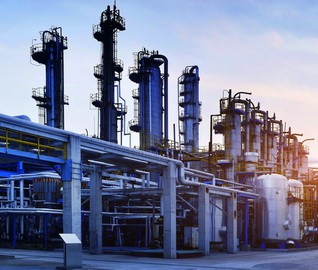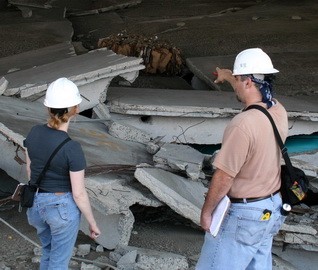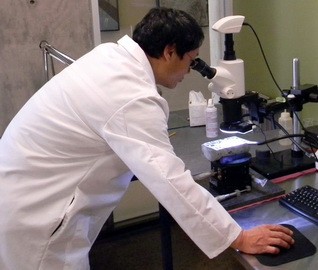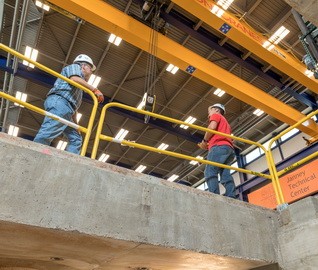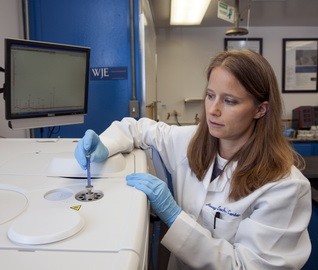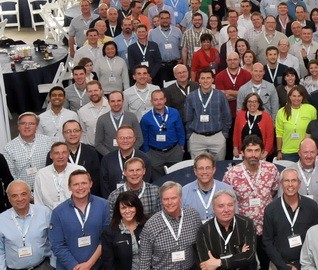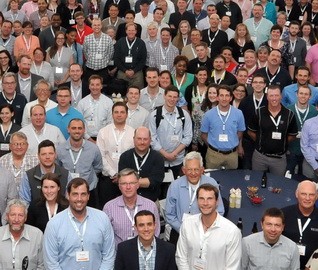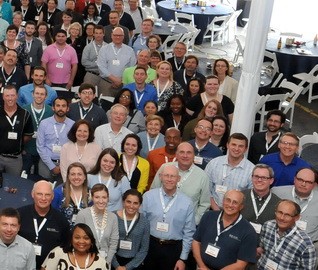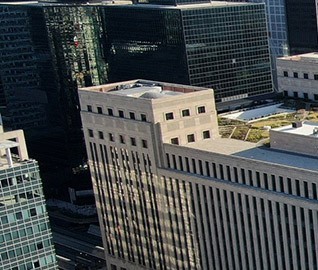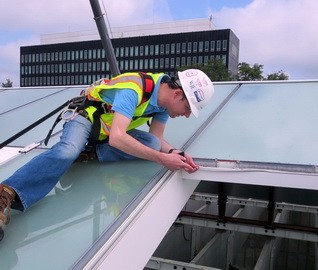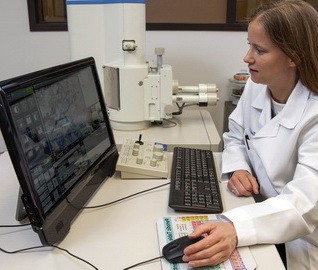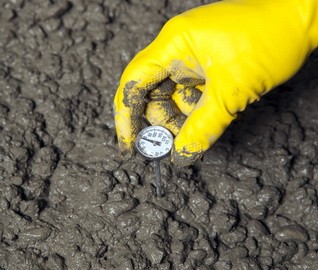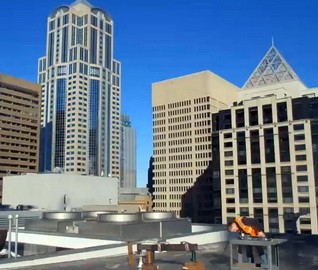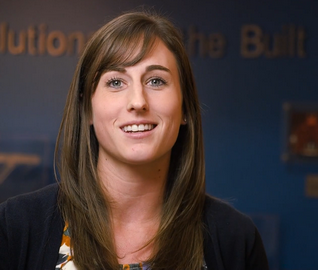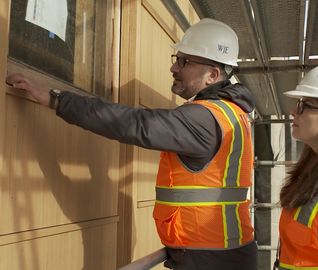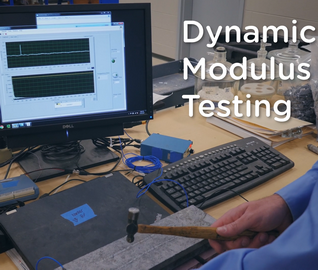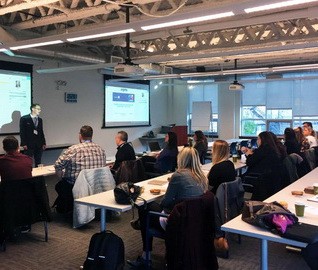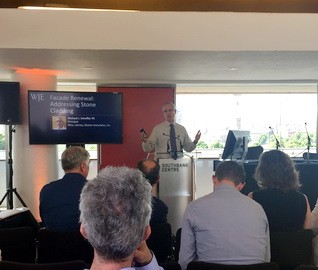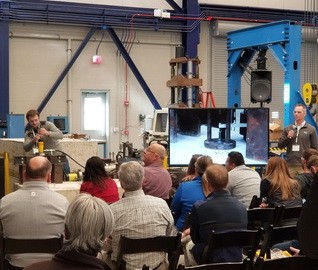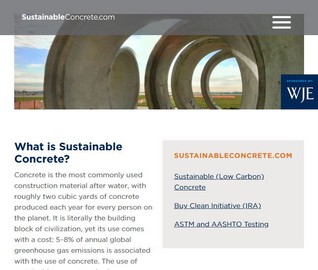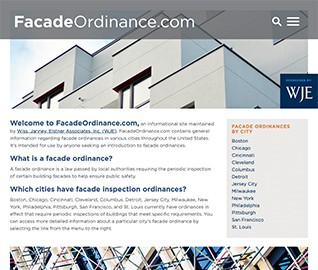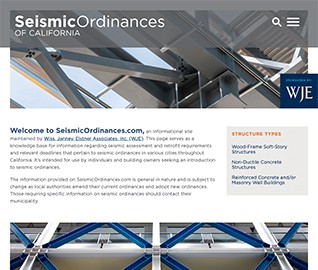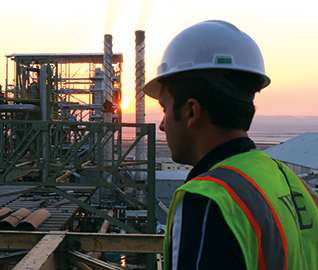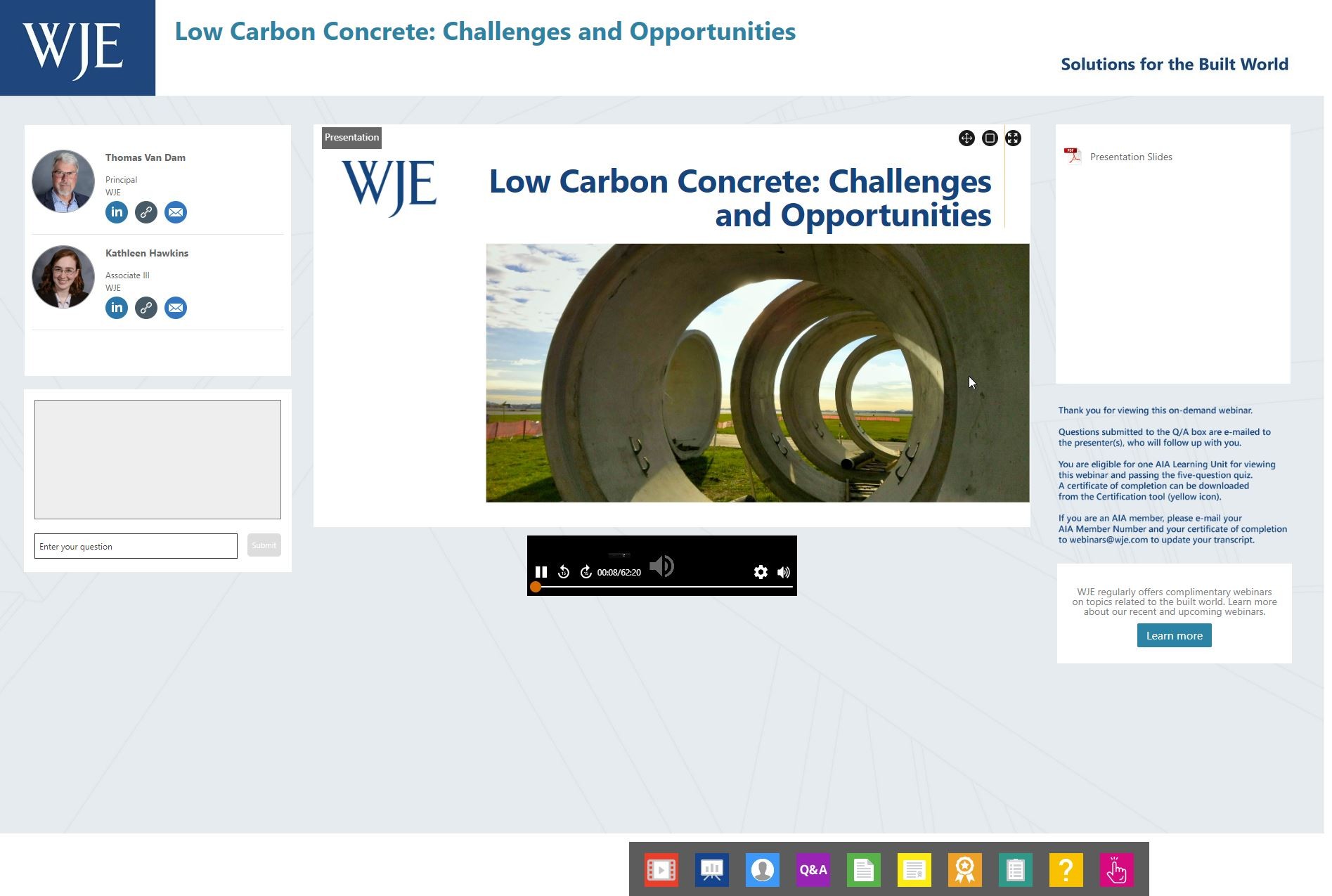Concrete is humankind’s most commonly used material after water, with roughly 2 cubic yards of concrete produced each year for every person on the planet. It is literally the building block of civilization, yet this intensive use comes with a cost: 5–7 percent of annual greenhouse gas emissions are associated with concrete production. As a result, considerable efforts are underway to reduce the carbon footprint of concrete by both reducing the amount of portland cement clinker in cement and the amount of cement in concrete. Although effective in lowering the carbon footprint of concrete, these actions can pose challenges during construction and while in service.
In this webinar, WJE materials engineers Kate Hawkins and Tom Van Dam discuss methods to reduce the carbon footprint of concrete using currently available and emerging technologies, the use of environmental product declarations to benchmark and assess improvements, and strategies to identify and mitigate potential challenges posed by the use of lower carbon concrete.
By the end of the webinar, you will be able to:
- Describe the main sources of greenhouse gas emissions in the production of concrete
- Summarize technologies to reduce the portland cement content in binder and strategies to reduce the cementitious binder content in concrete
- Explain how the carbon footprint of concrete is verified through an environmental product declaration
- Explore challenges using low carbon concrete mixes in construction and while in service
more to learn
View this webinar in our interactive audience console to earn 1 AIA HSW learning unit, access related resources, submit questions to the presenters, and download a certificate of completion.
Thomas Van Dam, Principal
LIZ PIMPER
Hello, everyone, and welcome to today's WJE Webinar, Low Carbon Concrete: Challenges and Opportunities. My name is Liz Pimper, and I'll be your moderator. During the next hour, WJE materials engineers Kate Hawkins and Tom Van Dam will discuss methods to reduce the carbon footprint of concrete using currently available and emerging technologies, the use of environmental product declarations to benchmark and assess improvements and strategies to identify and mitigate potential challenges posed by the use of lower carbon concrete. This presentation is copyrighted by Wiss, Janney, Elstner Associates. And now, I will turn it over to Tom to get us started. Tom.
THOMAS VAN DAM
Thank you so much, Liz. Hi, I'm Tom Van Dam. I'm a principal at WJE with a real passion about this topic, so I hope that you enjoy this talk as much as I do. And with that, we'll get going. Learning objectives. By the end of this presentation, you'll be able to describe the main sources of greenhouse gas emissions in the production of concrete, summarize technologies to reduce the Portland cement content in binder and strategies to reduce the cementitious binder content and concrete, explain how the carbon footprint of concrete is verified through an environmental product declaration, and explore challenges using low carbon concrete mixtures in construction and while in service. To start with, I think it's really important to understand why carbon reduction is important. And just a couple of examples. There's massive government support right now behind carbon reduction in all elements of our economy, building materials being one of them, and therefore, concrete is one of those that they're concerned about.
So we see a lot of Buy Clean legislation moving through government at federal, state, and local levels. We see private companies are requesting that designers, architects, material suppliers provide low carbon alternatives. Our industry associations such as the Portland Cement Association, the NRMCA, the American Concrete Pavement Association, or the American Concrete Pipe Association, and many others are advocating with net-zero initiatives. And then professional organizations such as the American Concrete Institute, Structural Engineers Institute, and the American Institute of Architects are all supporting net-zero initiatives. So basically, all of our clients and owners are asking for this. And just a really brief example. These are some GSA Inflation Reduction Act limits that just came out. These are from May. By the end of this, you'll maybe have a much better feeling for what these numbers mean. But this is the kind of thing that is cropping up in specifications within legislation, where we're being asked to shoot for certain carbon reduction limits and implement that into our concrete.
As I mentioned, there's a lot of current funding support for change. And so FHWA, I do a lot of stuff on the pavement side and with infrastructure, they have awarded their first 27 Climate Challenge projects through various state highway agencies and even a tollway authority. There's Buy Clean initiatives in the Infrastructure Investment and Jobs Act that came out both for federal, state, local, and private. And then one that I'll talk a little bit more detail at the end about is the Inflation Reduction Act, which has 2 billion committed to the FHWA for substantially lower carbon content building materials, as well as 2.1 billion to the GSA to support the use of materials with substantially lower carbon footprint. So these are really motivating things to those of us in the industry.
When you take all these things together, you can see changes upon us. Our clients at WJE and elsewhere are asking for assistance in providing low carbon alternatives for their building materials. Funding is aligned to support this transition to lower carbon alternatives. There's a lot of strategies that exist to help address this need and more strategies are emerging. And then I think what's really important as an old person to see that this is really a motivating thing for our young workforce, they are eager to innovate and participate in this. And as Gandalf said, I'm a bit of a fan of the Lord of the Rings, "All we have to do is decide to do with the time that has given us." And then let's not forget our friend, Gimli, "Well, what are we waiting for?" And so with that, I think we need to look at the challenges that are upon us, and within those challenges, the opportunities.
And the first thing, change is difficult for engineers. Change is often more difficult than it's for others. But the thing to realize is, business as usual, the way that we have traditionally done things might not suffice. Traditional cement and concrete are carbon intensive, and I'll go through that in a moment. But because of their carbon intensity, there's a lot of focus on cement and concrete. And designs and materials are dictated by the past. We have conservatism in our codes and our specs. They have developed over business as usual over decades and decades, and now we have this opportunity in front of us to innovate and to actually change things up a bit. So why the interest in cement and concrete mixtures? And it's really a matter primarily of volume. And I want you to imagine that for every man, woman, and child on the planet, we use roughly about two cubic yards of concrete per year.
It's an immense amount of material, and it is not an exaggeration to say civilization is literally built with concrete. With great power comes great responsibility, and there's large economic, environmental, and social impacts from this use. So in the United States, in 2022, roughly 92 million metric tons of cement was manufactured and another 10 million or so tons imported. And this was linked to about 1% of the US greenhouse gas emissions in 2022. Worldwide, the number is estimated to be between 5% and 8% of global greenhouse gas emissions are from the production of concrete. So when we look at that, we can focus on this chart to put it into perspective. When we look at the bottom little quadrant here, this is where concrete lies. So from an embodied CO2 perspective, embodied energy, it's actually one of the lowest materials by mass. But concrete itself, we use it in massive quantities, and it's heavy, and as a result, it has this big impact.
So we are a very efficient material, and it's one of the reasons that concrete is so often used. But part of the problem is we use a lot of it. So where is the CO2 coming from, or the carbon coming from in the production of concrete? And if we look at the entire embodied carbon within that concrete, in a concrete truck, at the gate, literally, 89%, almost 90%, of the carbon associated with it is from making Portland cement itself. Obviously, the picture on the right shows the flame in a cement kiln, but actually, most, about 60%, of all of the CO2 associated with making cement is from calcining limestone. So we take calcium carbonate, we burn it at high temperature, and we're left with calcium oxide, which is what we want, and we drive off CO2, to the point that roughly 22% of the exhaust gases leaving a cement kiln are CO2.
So really, that is our challenge, is dealing with the Portland cement. Net result. On average, about 922 kilograms of CO2 equivalents per metric ton of cement made is from cement production in the US. So you've heard people save for every pound, it's about a pound, it's actually about 0.92 pounds of cement gives us about a pound of CO2. And then we take that cement, we combine it with our other ingredients, the sand, the gravel, the water, basically, to create concrete. So a typical concrete at the concrete plant gate has about 460 kilograms of CO2 equivalent per cubic yard, and roughly, 400 kilograms of CO2 equivalent is from the Portland cement. This takes us into our strategies that we need to do in the short term and intermediate term over the next three to five, and five to 10 years, basically, to reduce our carbon footprint.
The answer is very simple, get Portland cement clinker out of concrete. And this is done in two ways that we'll be talking about at length. One is cement optimization, and the other is optimizing our concrete. So cement optimization is to use alternative binders to minimize the amount of clinker. And then concrete optimization is basically to reduce the cementitious content in that concrete mix, while we improve workability and reduce shrinkage. And again, I want to stress, this is not simple, but it is not overly difficult, and that's what we're here to talk about. So with that, I'm going to introduce my co-presenter. Kate, I'm going to let you take it from here.
KATHLEEN HAWKINS
Thanks, Tom. So yeah, I'm going to focus on the first strategy that Tom mentioned, which is getting the clinker specifically out of cement. So considering the ordinary Portland cement that the industry has been using for a really long time, roughly, about 85 to 95% of that cement is from cement clinker. And I have a little picture here to show what that clinker looks like before it's ground. The rest of the ordinary Portland cement has some sulfate, typically in the form of gypsum, some processing additions to help with the manufacturer of the cement, and then we've actually permitted up to 5% limestone to be added into ordinary Portland cement complying with ASTM C150 for a number of years.
So what can we do to get the clinker out? A large part of that is substituting the cement. So we can use traditional supplementary cementitious materials, or SCMs, like fly ash and slag cement, which we've been doing for decades. I have silica fume in there, although it's not as prevalent as fly ash and slag cement. And then I have natural pozzolans in this list of traditional SCMs, which I'll get into why a little bit later. We've been substituting the cement with limestone, that's where the Portland limestone cements, or Type 1Ls, are. And then we've also been looking at alternative SCMs, such as alternative ashes from coal-fired power plants or ground glass pozzolans.
So when it comes to substituting that cement clinker or substituting cement, we've been focusing a lot on blended cement. So moving from ASTM C150, which was for our ordinary Portland cement, we've been moving into the realm of ASTM C595, which specifies prescriptive and performance requirements for blended cements. And it has four categories of blended cements that can be used. And the first is a Type 1S, which is a combination of Portland cement and slag cement. The second is a Type 1P, and that's a blend of Portland cement and a pozzolan. The Type 1Ls, of course, which are Portland cement and limestone. And then they have a ternary blended cement, or a Type 1T, and this will be Portland cement and two other components, it might be limestone and pozzolan, or limestone and slag, or pozzolan and slag.
But all of these blended cements can be specified as part of ASTM C595, or used in a specification that references C595. So to go into a little bit about each of those SCMs, especially the traditional ones here, slag cement and fly ash are both byproducts of other industries. The slag cement is a byproduct from the steel production industry, and fly ash is a byproduct of coal-fired power. We've been using these, as I said, for a very long time. Slag cements, we've traditionally replaced cement at substitution rates commonly from 20 to 70%, especially to get good durability, and the fly ash, from 15 to 40%. And the byproduct that comes from the steel production process is not ready to be used immediately, that needs some processing, which is typically just grinding to get slag cement at a powder form, and then of course transporting it to the concrete plant. Fly ash, we've generally been pretty choosy about which fly ashes we use from power plants. So typically, we haven't done very much to processes that have carbon emissions associated with them other than transporting them to the concrete plant.
And the bottom left map shows a bunch of slag cement plants and terminals that are in the continental US. And this was compiled from the approved product lists from the DOTs in the continental US about mid-2022. And you can see the slag cement plants and terminals. There's quite a few on the eastern side of the United States, and there's just a few on the western side, but there's very few in the center. And this is where the transport and the use of local materials comes into play. When you're thinking about, is this a good choice if I want to reduce emissions? Do I have emissions associated with transport that I don't find acceptable? So we have used these traditional SCMs typically for improved durability, they've helped improve our workability, and some of the biggest benefits of these SCMS is that they're very familiar to a large number of contractors across the nation.
So we don't often have too many challenges with their implementation, but they do have a few limitations. On the technical side, they often slow set or strength gain typically, and this can be addressed with admixtures and other technical solutions. But the bigger one we're facing right now is the limited supply. As Tom pointed out, we use a lot of cement and a lot of concrete, and if we want to substitute that cement, and cement clinker especially, we need high volumes of SCMs. And especially in the case of fly ash, because of either the closure of coal combustion plants or the switch over to natural gas, we're losing quite a few fly ash supplies. So where do we look for other SCMs? And one of the first places that we might think of is, what about other ashes from power plants? As I mentioned, we've been cherry-picking our fly ashes, and using the ones that meet ASTM C618, which is the standard for ashes, without really any meaningful processing needs.
But we can also use fly ashes that don't meet C618 right out of the plant and beneficiate them either through, for example, grinding, or a carbon removal process. Or we can even take a good fly ash and a fly ash that does not meet C618, and blend them together, so that we have an ash that would meet C618 and a larger volume of it. So these are examples of how we can use a higher amount of fly ash that we've also been implementing for a while. More recently, we've been looking into fly ash that's been reclaimed either from landfills or from retention ponds. And so this also increases the amount of processing, and therefore, the carbon emissions, although not near the amount that's generated from cement clinker production. Because now, we have the removal process, especially from retention ponds, there's a drying step, and then there also may be beneficiation processes needed.
And then lastly, there's also coal bottom ash, has received a fair bit of attention recently, and this is, whereas the fly ash is what is flown away in the exhaust fumes, the coal bottom ash is what collects at the bottom of the coal combustion chamber. And so it is not quite the same as fly ash, it is in fact still covered by ASTM C618, for anyone who is specifying an ash or the use of an ash, but it's a more angular material, it has slightly different chemistry often. So these materials, they all fall under C618, but they aren't necessarily interchangeable, and there needs to be an awareness of that.
So then I'm going to move on to natural pozzolans. The fly ash and the slag cement, as I pointed out earlier in the slag cement, there's quite a few sources on the East Coast, but transport often needs to be considered. So the good news is that, natural pozzolans are actually primarily supplied from western states with a few exceptions, these materials are often virgin materials that are pulled from the ground, so they're not a byproduct from other industries, and they encompass quite a few types of materials, such as clays, volcanic materials like pumice, shale, they have a wide variety. But as I said, they're not a byproduct, so their processing needs are quarrying them out of the ground, crushing them, and then quite a few will require calcining. And you can see in the list there's calcined clays and there's calcined shale. And calcining is basically heating them to temperatures typically up to about 1000 degrees Celsius, maybe 1,100 degrees Celsius, which of course is going to generate energy.
And just for comparison, when calcining cement, or when producing cement clinker, the temperature of the fuel... or the temperature need that's reached is often 1500 degrees Celsius. So there's still a benefit, but natural pozzolans do have some amount of processing involved. And another downside of natural pozzolans is the fact that they're not as familiar to as many contractors across the United States. I have included them in the traditional list because there's a long history of their use. This is actually a graphic showing some examples of where natural pozzolans have been used based on the history presented in ACI document 232.1R. And you can see there's projects all the way back to the 1910s, but these have often been, especially in the beginning, very singular projects in the west. As a fun fact for the day, natural pozzolans were used in the Golden Gate Bridge. So there's history, they're not as widely known as fly ash and slag cement.
So this is one challenge of the natural pozzolans, but they can still be used and their production has been increasing. Other SCMs. There's a number of alternative SCMs that can also help meet demand for SCM supply. As an example, ground glass pozzolan has been around long enough to have an ASTM standard developed for it, and there's quite a bit of innovation happening in this area as we try to meet demand for these SCMs to replace cement. For example, there's synthetic fly ash, there's a few processes that are focused on using CO2 to help mitigate CO2 emissions as well.
So that covers the use of SCMs in this strategy of getting clinker out of cement. Type 1L, or Portland limestone cements, are a hot topic right now based on how much is being used and how quickly we've been switching over to their use. The chart to the right here shows the percent of cement used in the US that is blended cement as of up to about may of this year. And we can see a very fast jump from late 2021 up to heading to about 50% earlier this year. And some of this is the Type 1P or the Type 1S, those other blended cements in the C595 specification that we talked about. But the majority of this is Type 1L. And so just to review very quickly, a Type 1L cement has a limestone content between five, which was the maximum amount permitted for an ordinary Portland cement, and 15%.
And you can see in the graph to the right that the 15% limit was put into place because of the desire to meet a similar strength to an ordinary Portland cement. Just to cover the processing the way we did for SCMs, the limestone used in a Portland limestone cement typically comes from the same source as what's used for the cement clinker. So there's very little transport costs there or emissions, and the limestone is an interground with a clinker. And the net impact of using this limestone and increasing the replacement rate is a carbon reduction of about eight to 10%.
So there's been quite a bit of research on Type 1L cements in their performance. And the general consensus is that, the performance is comparable to an ordinary Portland cement, but it is not exactly the same. And we'll get into that a little bit later because this is where the challenge of implementing this material has really lied. And lastly, my last slide on substitution of cement clinker and cements here is about limestone calcined clay cements, or LC3s. So LC3s have relatively little cement clinker in them. Here, I have a graphic showing a cement clinker of about 50%, but there's been some research driving that down even further. And the other two major components in an LC3 are a calcined clay containing kaolinite, typically, and a limestone. And so this classifies as a ternary cement, or a Type 1T.
And the amount of calcined clay to limestone is typically a 2:1 ratio. And research shows that the carbon reduction associated with the use of an LC3 can be 30%, or even more. So this has a lot of promise. It's not currently on the market in the US, although I'm aware of one manufacturer working to develop it. And there's been quite a bit of lab testing where it's shown good performance, and some demonstration or trial projects centered around Latin America and India. So this has been on its way. But one thing to note is that, an LC3 can be classified as a ternary blend for C595, or it might classify as an alternative cement if the limestone or the pozzolan exceeds the prescriptive limits of C595. And so this brings us to the specification ASTM C1157, and the method of instead of substitution, alternative cements. So I'm not going to go into these very much, I'm just going to point out that ASTM C1157 is purely a performance-based specification. And as such, anything that doesn't meet C595 will be able to fall under this specification if it's used in a project.
So this could cover geopolymers, it could cover carbon-sequestering cements. This is another big area of innovation similar to the alternative SCMs, where people are trying to find ways to innovate processes that emit less CO2 to develop a product that will perform as required. So some concerns when using these methods. When reducing the amount of our traditional Portland cement and cement clinker in binder, a lot of the design that happens is really for the hardened properties, especially the strength. And so there may be comparable strength, comparable durability properties, or even better durability properties, but there still needs to be attention given to the fresher plastic properties, because a lot of these materials can slow hydration or affect the amount of bleeding. And even if it's minor, this can still impact the actual construction process, specifically, timing of curing, timing of joint sewing operations, hard troweling, form stripping, and et cetera. And so there still needs to be attention paid to this, that we can still provide quality products even using these alternative materials.
So just as some final thoughts about using these materials and implementing them. Some of the questions that need to be asked is, first of all, are these materials going to be able to meet the performance requirements of our applications? And this is a question that's commonly answered even when the goal is not to use a relatively low carbon material, but any alternative material, this question is answered through prequalification testing to say, "Yes, this meets the strength," or for example, the durability, or the slump that is needed. And another question that has to be asked at the same time is, are these materials available? And this comes into some of the materials that have been discussed, need to be scalable, or will be scalable so that they can be used widespread across the nation. But other solutions can be regional or local, based on the available materials or the available expertise in the locality, and there needs to be an awareness of which one is being used. Are these materials economically feasible? We're talking a lot about low carbon concrete, but when it comes to the broader sustainability, economics do still play an important role.
And then there's been a lot of lab testing demonstrating that these materials can perform, but moving from lab testing, even prequalification to implementation, and successful implementation in the field really relies on trials or demonstrations, and then good quality control plans through the project. And so with that, I'm going to shift over back to Tom to talk about our second strategy.
LIZ PIMPER
Tom, you may be muted.
THOMAS VAN DAM
Had something really pithy to start that whole thing off with, but thanks, Kate. Yeah, I was muted, but now I'm unmuted, so we're back. So yes, basically, the next step once we've optimized the amount of clinker in the binder is to get the binder out of concrete. And conceptually, this is very simple. We just need to replace cement with aggregate. But in practice, this becomes very difficult. When we think about the way that we proportion concrete mixtures, it's as much an art as it is a science, as a matter of fact, it's probably more art, and relies exceedingly on empirical knowledge. The key here is we need to move away from our traditional approaches to proportioning, such as the absolute volume method that is featured prominently in ACI 211, in 301, the PCA's Design And Control, and move towards other tools that will allow us to maybe start with the aggregate structure first.
And this overall thing is called mixture optimization. This is an illustration, this is a mix design from real mixes that were submitted for a low carbon project. And I throw this up here to illustrate how a typical absolute volume mix design would occur. What you'll notice is, the amount of coarse aggregate across the board, the amount of fine intermediate aggregate across the board, remains the same, the amount of water is fixed, cement is increased, and then we compensate for that increase in cement by taking away some of the fine material. And then from that, we generate what is known as that Three-Point Curve, which in this case has four points, but it illustrates a water cement ratio versus strength curve that we're all familiar with seeing. The problem with this approach is, in it, slump is related to water content, in this case, 271 pounds per cubic yard.
The water-to-cementitious ratio therefore changes by just adding in more and more cementitious materials. So we go from 450, to 550, to 650, to 750, and the corresponding, we go from 0.60, 0.49, 0.42, to 0.36 water cement ratios. As I mentioned, we're holding the coarse and intermediate aggregate contents constant, sand content decrease to compensate for the increased volume of cementitious. And often, people then will not take into account that they have a history of producing mixes and actually use their mixed standard deviation, but they just choose the over-design right out of ACI 301, which then also leads to shooting for higher strength targets. When we do this by increasing that cement in 100 pound increments, and then therefore lowering the water cement ratio, this is obviously where our strength increase comes from, and permeability decrease comes from. But there's no consideration to this approach of the role of a water-reducing admixture, which is very, very effective in reducing the water content.
More importantly, is we're not doing anything with this aggregate grading, we're just keeping it constant, and we're not really doing anything to reduce the void space between the aggregates. And as such, we end up putting a lot more cement into the mix than we potentially need. Now, there are numerous tools available that can help guide that aggregate optimization problem. What we do know though is, before we embark on this fully, of reducing the cementitious content, there are some problems that we have to confront in construction. One of them is less cement means less heat generated. The reactions between Portland cement and pozzolanic materials are exothermic, meaning, they generate heat when we move to a mass concrete placement, for example, this can work to our advantage, to put more and more SCMs in there, take that heat out of the mix. Or in hot weather, it can help the mix potentially be a little cooler. But when we're in cool weather or when we need early strength, we need to strip forms, we need to get onto the slab more quickly, that can pose a problem for us. Less cementitious materials also mean that your moisture control at the plant has to be better. We recognize that if we have water that's unaccounted for in our aggregate stockpiles or leftover in the truck from wash water, that can have a bigger impact on our water cement ratio than it would with the lower cementitious content mixes than the higher. We can end up with problems with finishing. These are most profound if we don't optimize our aggregate. And what we find is, with an optimized aggregate situation, we actually improve our finishing. And then more cementitious materials are required for some aggregates. We know with manufactured sands, for example, that we have more surface area that will need more paste.
Some poor quality aggregates do need more cementitious materials than others would need. But it is important to remember, and this is a very key takeaway, increasing cement content does not necessarily increase strength. And this is a chart for various mixes with different water cement ratios generated by the National Ready Mixed Concrete Association. And what you will see is, for any given mix, or any given cementitious materials type, you will see, increasing the cementitious content, either at the one day or the 28th day, has no impact, or even in some cases, a slightly negative impact, on strength. The difference becomes even more profound if we look at permeability, where there's a general trend, everything held constant, as we increase cementitious content, we actually get more permeability. And so this is fine. That's lab treat, you can say it's a study. This is data from a project that I was involved with, Project NEON.
This is the reconstruction of the interstate through Las Vegas. And the mix in the blue was a 500 pounds per cubic yard mix with 20% fly ash. The mix in red was a 611 pounds per cubic yard with 20% fly ash. And what you'll notice here, these were placed in a cooler time for Vegas, and believe it, it does get cool in Vegas. So there were some issues with strength, but by the time we moved into the May, June, July, the one-day strengths may be slightly higher with the extra 111 pounds of cementitious, but the 28-day strengths were actually statistically the same and potentially trending a little lower with the higher cementitious content. So that's a real world example. So how do we do this? We can't just take cement out without adjusting the aggregate gradation. And so we really need to revisit the way we proportion mixtures.
We need to rethink and find life beyond that Three-Point Curve, that whole 12-step process, to come up with that, and use tools that are available such as the Tarantula Curve. And you'll be getting copies of this presentation so you can look up this excellent work done by Tyler Lay and his team at Oklahoma State. And in the void ratio method, which uses the Tarantula Curve, this is at the National Center for Concrete Pavement Technology, and downloadable. And always remember, these proportioning tools are first guesses, or gets you in the ballpark, it's an iterative process. But I do want to summarize the difference in the void ratio method. And in that method, you basically start by doing... basically, you optimize your aggregates, you figure out how much space is there between the aggregates, and you add a little extra paste, actually about 20 to 30% more, to get between the aggregates, and by avoiding that extra paste, you can minimize issues with strength, permeability, shrinkage, and have better sustainable mixes. And so the way you approach it is you first select your aggregate system, so it's a very different approach than what we've traditionally done, we select the paste system that we want for durability, water cement ratio, what kind of binder we want, and then we select that paste quantity or volume to just push the aggregate particles away just enough to get workability.
So when we think about these strategies, putting them together, a great example was what was built at MnROAD in last summer. So MnROAD, for those of you who are unaware, it's actually a research site partnership that's done by the Minnesota DOT in partnership with the National Road Research Alliance, 11 states participating this, 50 industries, associations, and academia. And what they simply have done is pulled a stretch of I-94 and ran it parallel to this research site. And then this allows us to build real-world type control sections within here to test. And so it's an excellent place to demonstrate technologies in real-world application. And back last year, working with Larry Sutter, we were able to develop a test site with 16 test cells. This had two control cells, one optimized mixture, where we went from the standard 570 pounds per cubic yard mix down to 501.
There was three CarbonCure cells, eight alternative SCM cells, and two alternative cement cells. All of these sites were built June... I mean, July, August of last year. And basically, when you looked at some of these mixes, there was significant carbon reduction. A report is about to be released on this, and then the work is continuing today. But just to let you know, some of the most better performing mixes had some of the lowest cementitious contents in them. So the broad challenges that we must overcome is, change is difficult and perceived to be risky. The Licensed Design Professional, who's responsible for their designs, have to always consider life-safety first. And so that cannot be compromised, but yet, working within that context, there's still this possibility to innovate. One of the major barriers that we've identified is risk often falls onto general contractors and suppliers, who the designer will specify a low carbon concrete mix, the designer will go forward with it, the owner wants it, but ultimately, it's all boils onto the contractor making it work, and that creates a lot of risk for them and makes them not want to do this.
So the only way that we can advance the practice is really through risk sharing, collaboration, and demonstrations. All of this is meaningless unless we have a way to actually assess if we've been effective in reducing carbon. And basically, the most common way to do this is through basically using an EPD based on life cycle assessment. So this is an example of environmental product declarations. Now, environmental product declarations are developed from a set of rules called product category rules. These rules are established through a collaborative process in which industry professionals and those outside the industry weigh in, and from that, a lifecycle assessment is run according to ISO standards. Once the LCA is done according to the PCR, it generates this environmental product declaration. I know a bit of word soup there, it's something to learn, but the thing to remember is that EPDs are done in a very systematic way, all of the EPDs that are done in North America are done under the same set of rules.
And those that are the LCA practitioner, the lifecycle assessment practitioner, is following those rules to generate the EPD, making the products that are within a certain product, like cement, comparable. And this just shows the average greenhouse gas global warming potential, or the equivalent CO2 for cement in US, is at 922 kilograms per metric ton. I threw out a few extras, Holcim Ste. Gen Type I/II is at 748. Very efficient plant Ste. Genevieve is. But when they blended their early model version with 8% limestone, they were able to get about a 24 kilogram equivalent per metric ton reduction, and that has since been increased as they blend more limestone in. Fly ash typically comes in at a very low. And then this is the one for basically ground glass pozzolan. It's higher than fly ash because the glass has to be ground to make it suitable for use, but it's still considerably lower than it is for cement.
These are values from Ciment Quebec. These were submitted into the Boston region. And I bring these up because, again, they're very low because they use hydropower. But this just shows you what you can do, they have their Type 1, a Type 3, a performance-based material, a Type 1L, and then a blended product. And so as a user, you can select the different environmental impact of the binder for your project by requesting an EPD. And so again, this one, you can take that and use that then into input into an EPD for your concrete. And this is the concrete that we use at the MnROAD Project. It had a very low global warming potential due to the fact that it was 30% fly ash with the Type 1L cement, and it was actually much below the national average. So as you start to think about how you can use EPDs, environmental product declarations, in your work, this allows you to look at different material combinations to come up with ultimately the carbon footprint of your concrete.
In conclusion, I want to talk about a couple of efforts that we have going on right now that are supporting decarbonization. WJE is part of a team working with Nichols Consulting Engineers, Larry Sutter, Doug Hooton, and Al Innis Independent Contractors and funded by Breakthrough Energy Foundation and Climateworks on a couple of big initiatives.
One of them is that we are going after trying to help the DOTs connect with IRA funding. As I mentioned, there's $2 billion available for low carbon transportation material grants. And the announcement for this is expected to come out. They've now delayed this to sometime later this winter, they're saying. So we're expecting it maybe end of November, and applications, sometime in December. But we have created a Reduced Carbon Concrete Consortium. And so far, we have 23 state DOTs that are interested in participating, and we're partnering with the American Concrete Pavement Association, National Center for Concrete Pavement Technology. And if you are an agency, either a local agency or a state agency looking to participate in this, please reach out to us. We're also working with what's called the Green DC Futures Team, this is supported by Breakthrough Energy Foundation. And we're working with basically Amazon Web Services, Meta, Microsoft, Google, through this group to publicize their iMasons' open letter on carbon reduction to get other partners involved.
And basically, what we're looking is seeking feedback from others for common challenges in implementing low carbon concrete. So these companies are committed, they're looking for other companies that are committed, and we are assisting them in trying to advance low carbon alternatives. A direct impact of doing that has been a tilt up panel demonstration that is going to be constructed next month. Again, we're partnering with Amazon Web Services, Clayco/Concrete Strategies, who are going to create the tilt up panel, and Ozinga, who's going to provide the 1157 performance cement. And basically, we're going to full scale production of panels that will be tilted up. We're going to be measuring, strain gauging, and lots of test data, and be publicizing that, as that information becomes available. So basically, current and future steps, we're working with stakeholders to establish reasonable carbon reduction targets for location application, providing designers, contractors, suppliers with results to get substantial carbon reduction, and then really developing and providing training for all stakeholders.
So there is a lot of steps in our future for all of us in all of these things. And it's an exciting time to be working in this area. So closing thoughts. Low carbon to carbon negative concrete is both a challenge and an opportunity. There's a lot of research opportunities out there. There's a lot of innovation, and the challenges to implementation as they emerge must be addressed. It's a major shift in the way that we design, specify, test, and construct with concrete. And our industry is an industry that has been doing more or less the same thing for decades. And so this shift is one that has many of us uncomfortable, but it also is one that is bringing a lot of enthusiasm and excitement. And all of us who are working with concrete, whether we are owners, whether we are designers, specifiers, whether we are contractors, or suppliers, we all are affected by this and have a strong role to play in success.
And so summary. The overall impact of concrete is huge due to the volume that we use. We have strategies available to us now, and that more will be available to us within the next few years. And we need to embark on rigorous verification using environmental product declarations. And so there's a lot of funding available to support, and I think we're all excited about this journey. And with that, I think we have a few questions, is my guess.
LIZ PIMPER
Yeah, we do. Thank you, Tom, and thank you, Kate, for the presentation. Okay. Our first question, "Can you discuss the potential issues of matching historic cement mixes, at least in appearance and in behavior, when low embodied carbon cement is required? How do we deal with patches?"
THOMAS VAN DAM
I'll take that one if I could, Kate. Basically, the first thing I would say for you, and it's one that, in general, you might not be too concerned about the carbon footprint of the material. And I only say that because the volume is going to be lower, but you are still being forced to deal with a switch in cement. So for example, a Portland cement to a Portland limestone cement has a different color. And the only thing I could add is, you will need to do the same things you've done before, and they're going to probably just require reformulation, working with pigments and working within the same context, but you're going to have to redo a lot of things, I guess. And I know that's part of the change that will happen, is trying to match color, but it is something that we'll just have to do, and work with, really, your concrete suppliers to try to come up with the best matches. And I don't know, Kate, if you have any insights on that topic?
KATHLEEN HAWKINS
No, I think that what you said makes a lot of sense.
LIZ PIMPER
Okay. Our next question, "Are carbon capture technologies being investigated or used in the production of cement to reduce CO2 being released? If so, do the numbers presented by Tom at the beginning of the presentation reflect CO2 with or without the use of carbon capture technologies?"
THOMAS VAN DAM
Now, Kate, I'm up to speed on carbon capture if you want me to take this one.
KATHLEEN HAWKINS
Yeah. Yeah.
THOMAS VAN DAM
All right. At least I know what people tell me. They are being absolutely investigated. As I mentioned, 22% of the exhaust gases are CO2. It's a great place to capture that CO2 and then try to utilize it in a productive way. I believe that the first plant in North America with carbon capture technology has been outfitted or will shortly be coming online in Canada, I believe. And I believe there's also one already operational in Europe, so it's not reflected in the current numbers. I will emphasize, when carbon capture becomes more common, it would show up in the EPDs. And so a cement plant that did carbon capture would be able then to reflect that in environmental product declaration showing that decrease. There are hurdles though to carbon capture. Obviously, the technology is nascent and not really ready for primetime yet. It's really in a demonstration mode.
LIZ PIMPER
Okay. Our next question, "In mass concrete, fly ash is better than slag, but with limited fly ash availability, what can be done to the mix for better passive controls?"
THOMAS VAN DAM
All right, Kate, you go for that one.
KATHLEEN HAWKINS
Yeah, this is a good question. It really comes down to just investigating the materials that are available to you. We have acknowledged limited fly ash availability and how it's decreasing. I think it really depends on a case by case basis. I don't think I have anything off the top of my head that is widespread going to just do the job, that's been able to fill fly ash's traditional role in that. Tom, do you have anything to add?
THOMAS VAN DAM
Yeah. Actually, with mass concrete, you always develop a plan, you always look at the calorimetry curves in the materials that you have available. And although fly ash is becoming less available, a lot of harvested ash is going to become available in the future. I think, as Kate said, the best thing to do is to look at the materials that you have available, and then do the best you can with your thermal plan to try to come up with the most effective way to address it. But I do want to emphasize, and Kate covered it, reclaim fly ash is going to be become a thing, we're going to see less and less fresh fly ash coming directly from coal-fired power plants. But people are already, in many markets, effectively mining fly ash, whether from landfill or from ponds, and harvesting it. And so that will become available in markets as well.
LIZ PIMPER
Okay. Next question, "For limestone cement, is the carbon reduction a percentage of total carbon including the other clinker cement, or just for the limestone component?"
THOMAS VAN DAM
Yeah, this one deals with kind of back to the EPD question. So I know we went very quickly through the EPDs, but your EPD will reflect the total for the binder as being sold to the supplier. So when I showed the one for Ste. Genevieve Holcim I/II versus their 1L(8), you saw the reduction there, and it's for the entire cement as sold per ton of material per mass.
LIZ PIMPER
Okay. Next question. "Maybe I missed it, but how much more expensive, maybe as a percentage, is low carbon concrete compared to, quote, 'normal' concrete we use widely nowadays in the construction industry?"
KATHLEEN HAWKINS
I'll tackle this one.
THOMAS VAN DAM
Alrighty.
KATHLEEN HAWKINS
It really depends on which low carbon concrete. First of all, if you're using the traditional materials that are generally available and can be sourced relatively easily, there might not be much or any cost difference in some ways. But whenever you're dealing with a new material, there's an investment cost as well, and that might be reflected in a unit price as people get familiar with it. If you're using, for example, a low carbon concrete that uses replacement rates that are not that challenging right now, versus one that has slag at a 95% replacement rate, for example, the cost associated with using both of those is going to differ outside of just the straight material costs as well. So that's a bit of a challenging question in some respects regarding whether you're talking just about unit price, or if you're talking about the price associated with testing and the other efforts that go into developing low carbon concretes.
THOMAS VAN DAM
Absolutely. I just wanted to quickly add that, often, your low carbon alternatives can be cheaper, but at first, it's often going to be more costly because it's new and the perception of risk, might not even have any risk, but there's a perceived risk.
LIZ PIMPER
Okay. Next question. "Is there any reduction in long-term strength with a new substitutions for fly ash?"
THOMAS VAN DAM
I would say, not that I know of, none that I've seen demonstrated. And I think the biggest concern with some is when we get into some of the absolutely novel materials, that maybe we're not that familiar with, there is concern about longer term durability and strength. But most of the systems that we're dealing with in the short and intermediate term are still basically relying upon the same chemistry that we've come to know, the same kind of microstructure, and so our expectations would be that our long-term strength and durability would be similar.
LIZ PIMPER
Okay. We've got time for one more question. "Can you please explain in greater detail what the challenges are that contractors are facing in using low carbon concrete in the field, such as finishing, set times, cracking, et cetera?"
THOMAS VAN DAM
Yeah, and Kate, I'll take this if that's all right. Anytime we have change and something is different, it will impact construction, and it's even if we just change cement source from one cement plant to another. I think as we move towards a continued reduction in carbon, the changes are going to be a little bit more profound, and it will require adjusting our strategies in the field. And I know the biggest industry that's been impacted by the movement towards the Type 1L cements has been the slab on grade industry, where they are amazing contractors who have their process down to an art form, literally, and all of a sudden a bit of a wrench got thrown at them when the cement one day showed up and went from a I/II to a 1L.
I think what I'm hearing is that adjustments are being made. For the most part, things are getting back on track, and I think this is an important thing for all of the industry as we move forward. We need to move forward purposefully and with knowledge, and we can't just, all of a sudden, upset the apple cart and expect one group of stakeholders to bear the brunt of it. So I know in markets where the 1Ls were introduced over time and a little bit more thoughtfully, no issues existed. But in others, we saw these issues. So back to some of the closing comment, it's going to take all of us as stakeholders to contribute, and to meet, discuss, talk about successes, when we have failures that occur or difficulties, to voice those, address them, and move forward.
And I think what you will see is that we're going to be a smarter industry, we're going to be a better industry, we're going to be a more competitive industry, and we're going to be an industry with a lower carbon footprint. And so I think it's a very powerful message for us, but I also do believe we have to be cognizant that it's not all the same, it will be different.
LIZ PIMPER
Okay. Thank you, Tom. Thank you, Kate. That is all the time that we have for questions today. We'd like to thank you all for joining us. We hope it's been educational. If you have any questions about today's presentation, please don't hesitate to reach out to Tom or to Kate. And if you have questions about WJE webinars, please reach out to us at webinars@wje.com. So again, thank you so much for your time, and we hope you have a great rest of the day.
RELATED INFORMATION
-
 Thomas Van Dam, PrincipalWJE Northbrook MORE >People | Thomas Van Dam, Principal
Thomas Van Dam, PrincipalWJE Northbrook MORE >People | Thomas Van Dam, Principal -
 Kathleen A. Hawkins, Associate IIIWJE Northbrook MORE >People | Kathleen A. Hawkins, Associate III
Kathleen A. Hawkins, Associate IIIWJE Northbrook MORE >People | Kathleen A. Hawkins, Associate III -
 WJE's sustainable concrete practice aims to be your consultant of choice when applying the... MORE >Services | Sustainable (Low Carbon) Concrete
WJE's sustainable concrete practice aims to be your consultant of choice when applying the... MORE >Services | Sustainable (Low Carbon) Concrete -
 WJE's Janney Technical Center (JTC) provides advanced testing and forensic capabilities to... MORE >Labs | Janney Technical Center
WJE's Janney Technical Center (JTC) provides advanced testing and forensic capabilities to... MORE >Labs | Janney Technical Center


